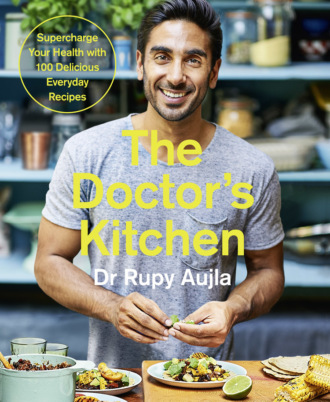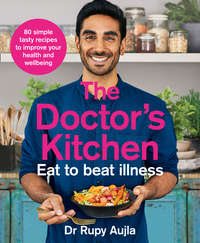
Полная версия
The Doctor’s Kitchen: Supercharge your health with 100 delicious everyday recipes
Once you know how to use cacao, it becomes worth the expense, and since the ‘drink of gods’ has become so popular, it has also become a lot cheaper! The lengthy process of making the raw powder justifies its price, and the depth of flavour it offers makes it a worthwhile purchase. Look for 100 per cent powder, not cocoa with added dried milk products and sugar. Follow some of my simple recipes (see here and here) to discover how versatile it is in both savoury and sweet dishes and acquire the taste for this wonderful ingredient. You can get the same nutritional benefits from using high-quality dark chocolate powder, which I don’t think I could live without (75 per cent cocoa solids or higher is ideal).
Quinoa
I still get some eye rolling when I mention quinoa to my colleagues! But quinoa in all its coloured varieties is a really worthwhile addition to your diet. It’s good value and widely available, it’s easy to cook and it has a better nutritional profile than rice, bread or pasta (higher in protein, with more vitamins and minerals186), plus we even produce some right here in the UK! It contains all essential amino acids and the dark varieties possess even more antioxidants than the white.
It has been labelled as a potential ‘functional food’, because it may help reduce the incidence of high blood pressure, metabolic syndrome and stroke.187 This is quite a claim to make, given the lack of human studies testing these theories,188 but is certainly an area to watch.
Note, however, that these potential benefits don’t extend to every product just because it has quinoa in it. If a chocolate bar has some sprinkled puffed quinoa grains on top, this does not automatically make it a protein-rich, blood-pressure-reducing functional food! I recommend cooking with whole quinoa, and using it in both savoury and sweet dishes.
Extra-virgin olive oil
A cornerstone of the Mediterranean diet, the popularity of this polyphenol-rich fat has fluctuated in recent years, as it has found itself caught up in the battle of opinion on what constitutes a healthy plate, but I use good-quality olive oil liberally.
In the context of a low-sugar, nutrient-dense diet, olive oil has been shown to potentially be protective of heart health189 and, importantly, makes food so much more enjoyable. ‘EVOO’, as it’s affectionately called by health bloggers, is thought to reduce oxidative stress because of its good fatty acid content190 and rich diversity of phenolics.191 The role of oxidation and inflammation in heart disease has become well recognised in the medical community, so it’s probably the antioxidant effect of EVOO that makes it a heart-healthy ingredient.
It’s a staple in my store cupboard and fat of choice for lightly sautéing food, dressing dishes and making pestos. It remains stable (the chemical bonds do not break down) up to reasonable cooking temperatures around 170°C192 and the difference in taste between poor- and high-quality EVOO is noticeable to even the least refined of palates. Spend a few extra pounds on organic, cold-pressed193 olive oil – your heart will thank you for it.
Конец ознакомительного фрагмента.
Текст предоставлен ООО «ЛитРес».
Прочитайте эту книгу целиком, купив полную легальную версию на ЛитРес.
Безопасно оплатить книгу можно банковской картой Visa, MasterCard, Maestro, со счета мобильного телефона, с платежного терминала, в салоне МТС или Связной, через PayPal, WebMoney, Яндекс.Деньги, QIWI Кошелек, бонусными картами или другим удобным Вам способом.



